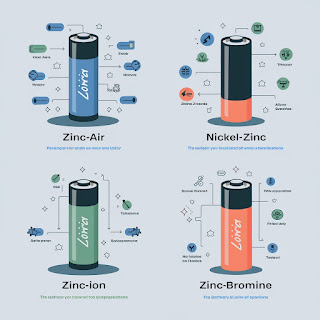Zinc Battery Market Set to Double by 2029: Trends, Segments, and Regional Growth Prospects
The zinc battery market is on a significant growth trajectory, projected to reach a valuation of USD 2.0 billion by 2029, growing from USD 1.0 billion in 2024. This expansion reflects a compound annual growth rate (CAGR) of 13.6%, driven by the demand for sustainable and efficient energy storage solutions. The increasing reliance on renewable energy sources and advancements in technology are notable factors propelling market growth.
Key Advantages of Zinc Batteries
Zinc batteries offer several advantages over traditional
battery technologies, which contribute to their growing popularity.
- Cost-Effectiveness:
Zinc, being an abundant and low-cost material, makes zinc batteries an
economical choice for various applications, particularly in energy storage
where cost management is essential.
- Safety
and Environmental Considerations: Zinc batteries are
non-toxic and non-flammable, which enhances their safety profile. Their
environmentally friendly nature and recyclability are increasingly
important in a market that demands sustainability.
- High-Performance
Characteristics: These batteries demonstrate high
energy density and reliability, making them suitable for applications
ranging from grid energy storage to consumer devices. The ability to
recharge multiple times adds to their appeal in applications that require
sustainable energy solutions.
Market Segmentation and Applications
The zinc battery market can be segmented based on battery
type, rechargeability, and application. Common types include:
- Zinc-Air
Batteries: Widely used in hearing aids and other
medical devices due to their small size and lightweight nature.
- Zinc-Ion
and Zinc-Bromine Batteries: These are expected to
dominate the market for rechargeable batteries, particularly in grid
storage applications which are essential for integrating renewable energy
sources.
The primary applications for zinc batteries span across
various sectors, including:
- Medical
Devices: Where the reliability and stability of
power supply are crucial.
- Automotive
and Transportation: With the shift towards electric
vehicles, efficient energy storage solutions are in high demand.
- Utility
and Energy Storage: Supporting the transition to
renewable energy and providing backup power solutions.
Regional Market Insights
The Asia Pacific region is anticipated to become the
fastest-growing market for zinc batteries, driven by rapid industrialization,
urbanization, and government investments in renewable energy projects.
Countries like China and Japan are at the forefront, with advancements in zinc
battery technologies and robust manufacturing capabilities.
Challenges Facing the Zinc Battery Market
Despite the promising growth, several challenges must be
addressed:
- Technical
Drawbacks: Issues such as dendrite growth on zinc
anodes can lead to capacity loss and safety concerns. Manufacturers are
actively researching ways to mitigate these drawbacks.
- Competition
from Alternative Technologies: Established battery
technologies, such as lithium-ion and lead-acid batteries, pose a
significant challenge for zinc batteries. The industry must innovate
continuously to remain competitive.
The zinc battery market is poised for significant growth,
backed by its advantages in cost, safety, and performance. With increasing
investments and advancements in technology, it is well-positioned to meet the
demands of various sectors, particularly as the world shifts towards renewable
energy solutions. As manufacturers address existing challenges and enhance the
technology, the future of zinc batteries looks promising, heralding a new era
in energy storage.

Comments
Post a Comment